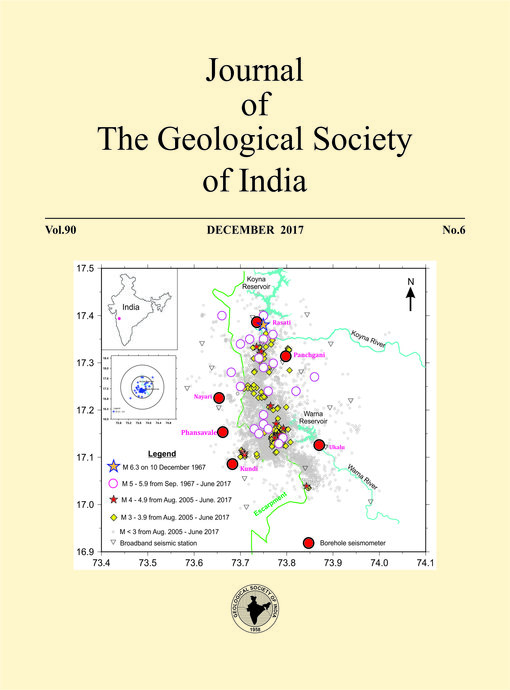Long-term Hydrochemical Earthquake Precursor Studies at the Koyna-Warna Reservoir Site in Western India
DOI:
https://doi.org/10.1007/s12594-017-0781-xAbstract
Koyna-Warna region of western India is an active seismic zone due to the Reservoir Triggered Seismicity (RTS). Earthquake precursor studies are carried out monitoring hydrochemical and stable isotope signatures in the groundwater from 15 bore wells since January 2005, for more than 12 years (January 2005 to February 2017). Depth of these boreholes ranges from 100 to 250 m. Cyclic or temporal variation in hydrochemistry is observed in few sensitive wells in Koyna region. The Govare well in Koyna is found to be most sensitive and the observed hydrochemical cycle is closely associated with local earthquakes of M > 5. The earthquakes M 5.0 occurred till date. The cyclic changes in hydrochemistry, however, indicate on-going earthquake processes and an impending earthquake of M > 5 in the region.Downloads
Metrics
Issue
Section
Downloads
Published
How to Cite
References
Barsukov, V.L. Varshsl, G.M. and Zamokina, N.S. (1984/85) Recent results of hydrochemical studies for earthquake prediction in the USSR, PAGEOPH, v.122, pp.143-156.
Chadha, R.K., Pandey, A.P. and Kumpel, H.J. (2003) Search for earthquake precursor in well water levels in a localized seismically active area of reservoir triggered earthquakes in India. Geophys. Res. Lett., v.30, pp.1416, doi:10.1029/2002GL016694.
Claesson, L., Skelton, A., Graham, C., Dietl, C., Morth, M., Torssander, P. and Kockum, I. (2004) Hydrogeochemical changes before and after major Earthquake. Geology, v.32, pp.641-644.
Du, J., Amita, K., Ohsawa, S., Zhang, Y., Kang, C. and Yamada, M. (2010) Experimental evidence on formation of imminent and short-term hydrochemical precursors for earthquakes. Appld. Geochem., v.25, pp.586-592.
Gupta, H. K. (1992) Reservoir-Induced Earthquakes, Elsevier Scientific Publishing Company, Amsterdam, 1st edn, p.470.
Gupta, H.K., Shashidhar, D., Pereria, M., Mandal, P., Purnachandra Rao, N., Kousalya, M., Satyanarayana, H.V.S. Dimri, V.P. (2007) Earthquake forecast appears feasible at Koyna, India. Curr. Sci., v.93, pp.843-848.
Gupta, H.K., Radhakrishna, I., Chadha, R.K., Kumpel, H.J. and Greksch, G. (2000) Pore pressure studies initiated in areas of reservoir induced earthquakes in India. EOS Trans. AGU, v.81, pp.145-156.
Gupta et al. (2016) Investigations of continued reservoir triggered seismicity at Koyna, India. Mukherjee, S., Misra, A. A., Calve‘s, G. and Nemchok, M. (eds) Tectonics of the Deccan Large Igneous Province. Geol. Soc. London, Spec. Publ., v. 445, http://doi.org/10.1144/SP445.11
Hartmann, J., Berner, Z., Stuben, D.and Henze, N. (2005). A statistical procedure for the analysis of seismotectonically induced hydrochemical signals: A case study from the Eastern Carpathisans, Romania. Tectonophysics, v.405, pp.77-98.
Ingebritsen S.E. and Manga, M. (2014) Hydrogeochemical precursors. Nature Geoscience, v.7, pp.697-698.
Igarashi, G.S., Saeki, N., Takahata, K., Sumikawa, S., Tasaka, Y., Sasaki, M. and Takahashi Sano, Y., 1995. Groundwater Radon anomaly before the Kobe earthquake in Japan. Science, v.269, pp.60-61.
King, C.-Y., Koizumi, N. and Kitagawa, Y. (1995) Hydrogeochemical anomalies and the 1995 Kobe earthquake. Science, v.269, pp.38-39.
Mallika, K., Gupta, H., Shashidar, D. Rao, N.P., Yadav, A., Rohilla, S. Statyanarayana, H.V.S. and Srinagesh, D. (2012) Temporal variation of b value associated with M £ 4 earthquakes in the reservoir-triggered seismic environment of the Koyna–Warna region, Western India. Jour. Seismol., v.17, pp.189-195, DOI 10.1007/s10950-012-9318-3.
Narain, H. and Gupta, H. K. (1968) The Koyna earthquake, Nature, v.217, pp.1138-1139.
Padill, G.D., Hernandez, P.A., Padron, E., barrancos, J., Perez, N. M., Melian, G., Nolasco, D., Dionis, S., Rodriguez, F., Calvo, D. and Hernandez, I. (2013) Soil gas radon and volcanic activity at E1 Hierro (Canary Islands), the 2011-2012 submarine eruption Geochem. Geophys. Geosyst., v.14, pp.432-447, doi: 10.1029/2012GC004375.
Rao, N.P. and Shashidhar, D. (2016) Periodic variation of stress field in the Koyna–Warna reservoir triggered seismic zone inferred from focal mechanism studies. Tectonophysics, v.679, pp.29–40
Reddy, D.V. and Nagabhushanam, P. (2011a) Groundwater electrical conductivity and soil radon gas monitoring for earthquake precursory studies in Koyna, India. Appld. Geochem., v.26, pp.731-737.
Reddy, D.V., Nagabhushanam, P. and Sukhija, B.S. (2011b) Earthquake (M 5.1) induced hydrogeochemical and d18O changes: validation of aquifer breaching – mixing model in Koyna, India. Geophys. Jour. Internat., v.184, pp.359-370.
Reddy, D.V. and Nagabhushanam, P. (2012) Chemical and isotopic seismic precursory signatures in deep groundwater: Cause and effect. Appld. Geochemistry, v.27, pp.2348–2355.
Reddy, D.V. and Nagabhushanam, P. (2016) Search for hydraulic connectivity between surface reservoirs and surrounding aquifers in the Reservoir Induced Seismic environment (Koyna region, India) using hydrochemical and isotopic signatures Jour. Seismol., v.20, pp.43–62. DOI: 10.1007/ s10950-015-9509-9.
Roeloffs, E.A. (1988) Hydrologic precursors to Earthquakes: A review. PAGEOPH, v.126, pp.177-209.
Sibson, R.H. (1981) Fluid flow accompanying faulting: Field evidence and models: Earthquake Prediction: An International Review. AGU, Maurice Ewing Series 4, pp.593-603.
Skelton, A., Andren, M., Kristmannsdottir, H., Stockmann, G., Morth, C.M., Sveinbjornsdottir, A., Jonsson, S., Sturkell, E. Guorunardottir, H.R. Hjartarson, H. Siegmund, H. and Kockum I. (2014). Changes in groundwater chemistry before two consecutive earthquakes in Iceland. Nature Geoscience, v.7, pp.752-756 doi:10.1038/ngeo2250.
Song, S.R., Chen, Y.L, iu, C.m, Ku, W.Y., Chen, H.F., Liu, Y.J., Kuo, L.W, Yang, T.F., Chen, C.H., Liu, T.K. and Lee, M. (2005) Hydrochemical changes in spring waters in Taiwan: Implications for evaluating sites for earthquake precursory monitoring. TAO, v.16 (4), pp.745-762.
Thomas, D. (1988). Geochemical precursors to seismic activity. PAGEOPH, v.126, pp.241-266.
Tsunogai, U and Wakita, H. (1995) Precursory chemical changes in groundwater: Kobe earthquake, Japan. Science, v.269, pp.61-63
Toutain, J P., Munoz, M., Poitrasson, F. and Lienard, A.C. (1997) Spring water chloride ion anomaly prior to a ML = 5.2 Pyrenean earthquake. Earth Planet. Sci. Lett., v.149, pp.113-119.
Toutain, J.P. and Baubron, J.C. (1999) Gas geochemistray and seismotectonics: a review. Tectonophysics, v.304, pp.1-27.
Ulomov, V.I., and Mavashev, B.Z. (1971) Forerunner of the Tashkent earthquake, Akad. Nauk. Uzb. SSSR FAN, 188.
Wakita, H. (1996) Geochemical challenge to earthquake prediction. Proc. Natl. Acad. Sci. USA, v.93, pp.3781-3786.

 D. V. Reddy
D. V. Reddy






